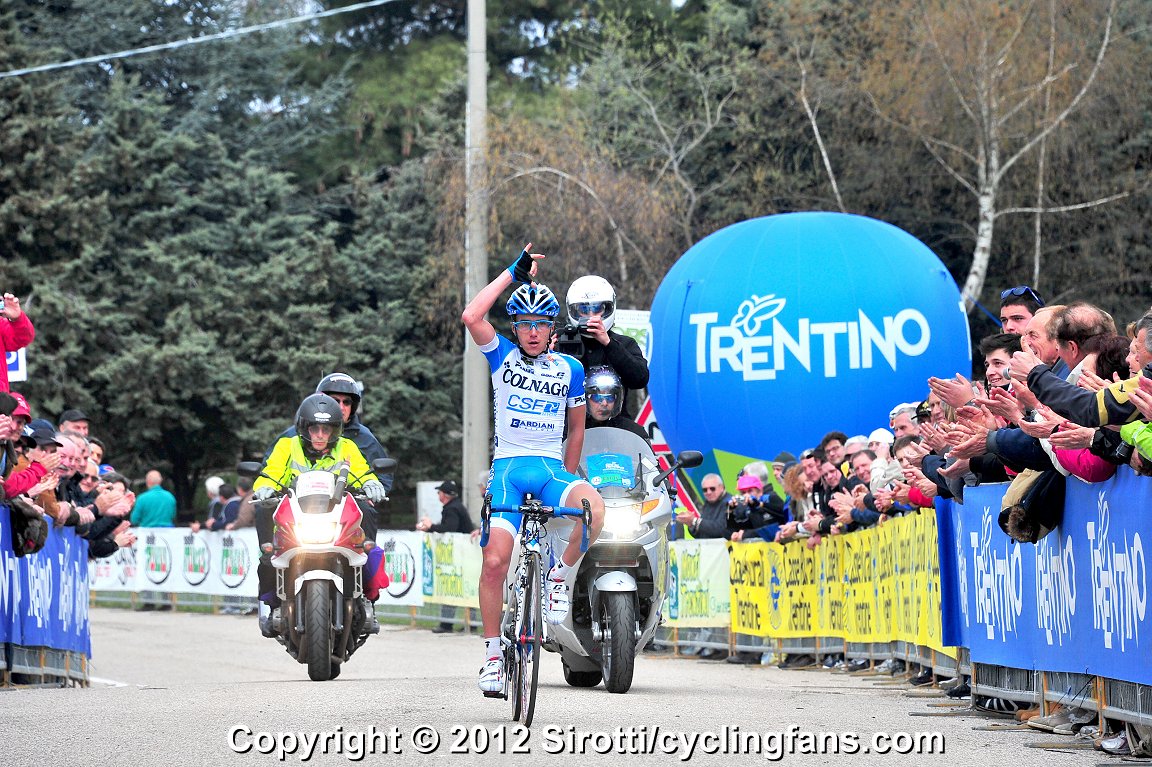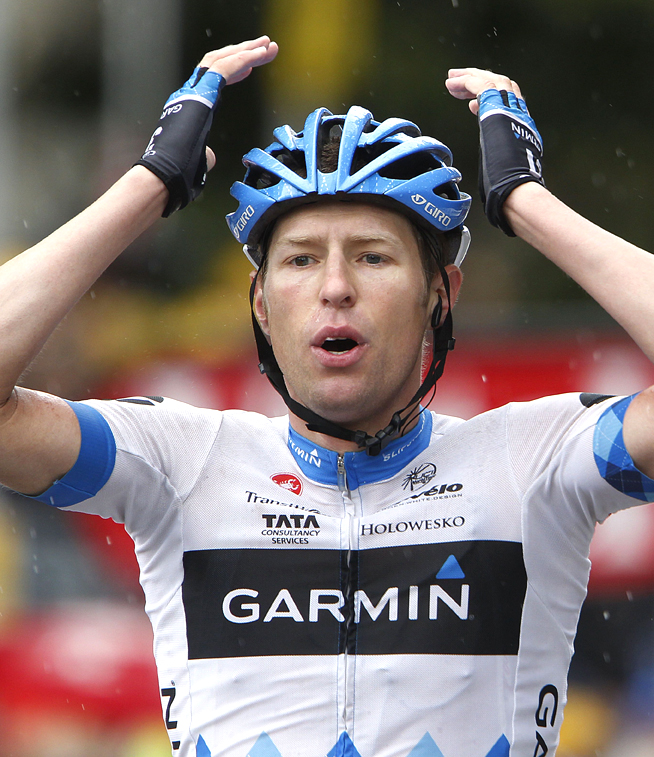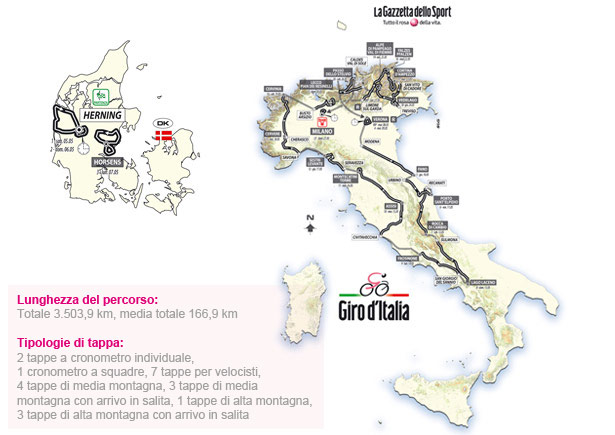So 3 days ago on Sunday, the first, hardest and most beautiful of the
Grand Tours came to an exhilarating conclusion. First of all, before the
analysis begins, congratulations to Ryder Hesjedal for winning the Giro. He was
the strongest rider throughout and deserved the win. It is a great win for Hesjedal,
Canada (there first GT win and podium), Garmin and clean cycling. In addition
commiserations to Joaquim Rodriguez, who rode a very strong race and would have
been a deserving winner and Mark Cavendish who missed out on the points Jersey
by 1 point.
There are a number of points to discuss about this Giro and
to review.
Things we learnt
One of the first big points to discuss was the very strong performance
of Hesjedal the winner and the inability of the big boys to crack him. Throughout
the Giro we were waiting for the big attack/s from Basso and Scarponi, however
these never came. I think it is fair to conclude that Basso pined all his hopes
on grinding Hesjedal of his wheel. Alas for Basso, Hesjedal was too strong. In
all fairness it could be that Basso wasn’t as strong as he used to be, for it
was a tactic that worked in 2010 against strong rivals such as Cadel Evans
(winner of TDF in 2011). Basso is now 34 and will turn 35 in December this
year, just before the start of the next season, so it perhaps is fair to say
his best days might be behind him. In addition, his preparation this year was hampered
by pre Giro illnesses and crashes. Scarponi also pined all his hopes on Hesjedal
cracking, and when that failed his attacks were not enough to drop Hesjedal. Given
his lack of acceleration and weakness in the time trial the inability to crack Hesjedal
always meant that winning would be difficult. Liqiugas’s tactics also saw to it
that Scarponi was worn down and therefore his ability to attack hard was
stunted.
Another key point is that riders like Hesjedal should never
be underestimated. There were probably a couple of opportunities in the first
and second weeks to take time out of Hesjedal, but these were not taken as the
other favourites were more worried about Basso. This proved crucial in the end
as Hesjedal won by only 16 seconds. In addition Hesjedal’s team,
Garmin-Barracuda were given an easy time throughout, due to that fact that
Liqiugas assumed responsibility for the favourites and expended a huge amount
of effort trying to control the race and hunt down attacks by riders such as
Cunego. This meant that there were exhausted in the key final week of the race
and that Garmin were fresh. In addition the strong pace set by Liqiugas
throughout the mountain stages helped weaken Hesjedal’s rivals, meaning that riders
such as Rodriguez who depended on attacking hard numerous times were hampered
in their efforts. Many have questioned the tactic of Liqiugas, but I think that
they were partly justifiable in that they were the best tactics for Basso to
win and that they were riding positively for a Basso win. When it came to the
crunch Basso didn’t have the firepower to drop the other favourites. Where I
think Liqiugas went wrong was that they didn’t adapt to the changing facts
quick enough. After Cervinia or at the latest Pian dei Resinelli, it should
have been realised that Hesjedal was a very serious threat and the work should
have been left to Garmin.
All this said this Giro showed that Liqiugas are a very
strong team, with a good number of talent riders who can perform on flat and mountainous
terrain.
It is clear from his performance that Hesjedal is a very good
rider, has capability to podium/win tour. He had shown previously in his career
that he had the necessarily attributes to do well, with good climbing and time trailing.
However having these attributes doesn’t mean that you can podium/win in Grand
Tours, with the added pressure and stamina needed to achieve this, to not have
a bad day and always be present in the crucial selections. Hesjedal passed this
test with flying colours and looked comfortable throughout, even when out under
severe pressure by de Gendt. It is fair to say that Hesjedal’s job and Garmin’s
job was made a bit easier by Liqiugas, but I think given his ability he would
have won even if that hadn’t been the case.
Now onto Thomas de Gendt; who rode onto the podium with one
of the greatest Grand Tour performances that I can remember (so since 1993). Thomas
de Gendt was an interesting rider coming into this season and indeed this Giro.
I had him down as a decent rider in my 2012 team preview, but I hadn’t anticipated
his improvement in Grand Tour’s and I didn’t have him down in my Favourites for
the Giro. In hindsight I should have as he has always been a good time trialist
and has had decent performances in Mountain stages before (Alpe d'Huez 2011
TDF). He came in with the aim of developing his skill in GT’s and achieved this
throughout with a top 10 placing going into the critical final 3 days, this
alone would have marked him out as a rider to watch for the future. However,
his performance in the stage to the Passo dello Stelvio was stunning. It was a
brave move as it came from ~ 50 km out, he had a good place in the general classification.
He took advantage of the hesitation in the leading group to build a good lead
on the valley road leading to the final climb of the Stelvio, using his strong
TT skills and a team mate to good effect. He then put in a massive effort to
keep a high pace on the climb, measuring his effort well to build and maintain
a strong gap until the last 2 or so km, after which he lost a small amount of
time. To be able to pull of this sort of performance shows great talent, with
strong climbing ability and good self awareness. Once in this position his
strong time trialling saw that he gained a podium place.
As well as showing us the talent of de Gendt, his
performance also highlights a number of other facts. Along with Andy Schleck’s
performance in stage 18 of last year’s
TDF, it shows that bravery is rewarded in Grand Tours and that long attack’s
can be very effective and could win races. It also shows that having a full
skill set more important than ever, with the ability to descend well and go
strong on the flat valley roads can be the difference between a top 10 and a
win/podium. The other very important conclusion is that teams are not as important
as they used to be. In previous times the other riders would have had more support
in chasing down such an attack, rendering such attacks as futile and energy
wasting. However, when Hesjedal was relying on his team mates Christian Vande
Velde and Peter Stetina the gap wasn’t closing, in fact towards the end it
started getting bigger. In the end it was left upto to Hesjedal himself to deal
with the de Gendt problem.
A final conclusion is that the Giro is still an awesome
race. It is in some ways a more “pure” cycling race than the Tour de France,
with a great skill set needed, more diverse terrain and more exciting racing. This
year’s course was great and lead to a lot of great racing. A few words of praise have to be said for Michele
Acquarone and RCS, the organisers of the race. They have run a very good and exciting
race, in addition they have done a lot of good work in making the race more accessible
with good promotion and an innovative openness, with a regular blog explaining decisions
made by them and giving an insight into the running and organisation of a bike
race. The organisers have made a very appreciate effort to listen and respect the
fans, giving them an input into the course of the penultimate stage to the Passo
dello Stelvio.
Riders for the Future
The Giro and Vuelta are often where promising young riders
are blooded into Grand Tours, giving the viewers the chance to see the winners
of the future first show there potential. This year was no different with a
number of riders showing strong talent. I will go through a few now, this is
not a comprehensive list.
Sergio Henao
Sergio Henao put in a very decent first GT’s performance to
finish 9th. This is a good sign that this talked about, talented Colombian
will live up to the hype. He still will be a rider to consider in every GT he
rides from now and at the age of 24, there will be a few. He has shown very
strong climbing ability and a good time trailing ability.
Rigoberto Uran
Henao’s compatriot and team mate on the Sky team also put in
a strong performance with very strong climbing ability and a good time trailing
ability. His consistency was good, with only a couple of bad days’ were he lost
a couple of minutes. The more he rides the strong he will get and the better
his consistency will be. He will very probably be a future GT winner.
Diego Ulissi
I have talked about Ulissi a number of times on this blog.
This Giro only reinforces my opinion that he will be a GT/hilly classics rider
for the future. He is still very young in cycling terms, 22, but he gained a respectable
21st place (4th in the young riders classification), all
the more impressive given that he was a domestique for Scarponi/Cunego and he went
into a number of mountain breakaways, expending a good deal of energy in the
process.
Matteo Rabottini
Rabottini’s performance in stage 15, that yielded him the
stage win was nothing short of epic. He showed great climbing talent in being
able to ride solo over difficult terrain for 150 km and great tactical ability
in marking Rodriguez when he was caught, latching onto his wheel and timing his
effort perfectly to out sprint one of the strongest uphill riders in cycling.
This stage win formed the basis of his King of the Mountains competition success,
and he rode well and bravely to win that competition and it was a well deserved
win. He is only 24, and with the climbing and tactical ability he showed during
this race he has the potential to do great things.
Damiano Caruso
Another 24 year old who rode very strongly this year with 5th
in the young riders classification. On the face of it, his performance might
not look that strong gaining only 24th, however this has to be put
into context. He did a huge amount of work for Basso, destroying the peloton
and narrowing it down to a select group. In addition he was often present,
working for Basso when the key 5-10 men group of favourites had been formed. Had
he not had to do all of this work, he would have had a much stronger result. He
has strong climbing ability and decent time trialling. With Nibali possible moving
teams next season, he migh have the chance to shine.
Andrea Guardini
Andrea Guardini has been much talked about by the Italian
press for a couple of years now as the sprinter for the future. With his stage
win in Vedelago, impressively beating Cavendish in a fair sprint showed why. On
his day he is very quick. However as the earlier stages of the Giro showed, he
has work to do on his positioning for sprints and his general stamina, both of
which need to improve if he is to fulfil his full potential. However at the age
of 22 there is plenty of time to do this.
Tom-Jelte Slagter
Was the rider who provided any sort of success for Rabobank
in this Giro. Althoug he didn’t podium on any stages, he showed strong ability
into the stage finish in Assisi, which suggests he is a man of the future for
the hilly classics. He rode very strongly and if he had more experience and tactical
knowledge, he would have timed his effort more effectively and could well have
won the stage,
Taylor Phinney
Showed his talent by a very strong performance in the
prologue, winning convincingly. He is still only 21 so has time to develop and
a GT this early in his career will help him in that. He may well have won the
final time trial if it wasn’t for a guiding police motorbike who took a wrong
turn. He is a very strong and powerful rider. Is too early to tell his full potential.
Gianluca Brambilla
Only 24 years of age, Brambilla put in a strong performance
this year finishing 13th. He has strong climbing ability and
therefore could be a future GT winner.
The Course
The way that the World Tour system works in cycling has been
a problem for the Giro in previous years with teams send poor squads. This wasn’t
the case this year, with the teams respecting the Giro. Almost all the teams
had good Giro’s with aggressive riding, stage wins, classification jersey’s etc.
This was good to see.
















